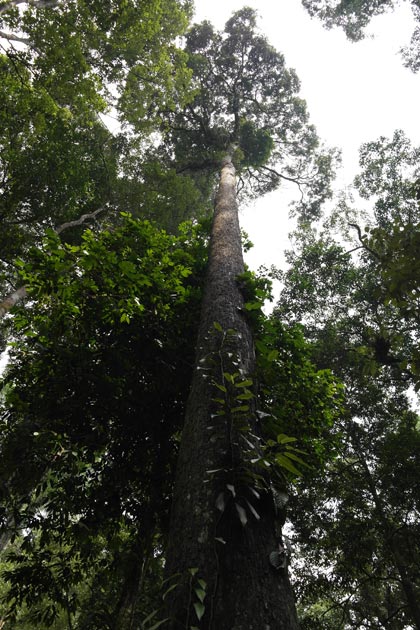Author
By Jungle Boy







https://www.rainforestjournal.com/chengal-neobalanocarpus-heimii/
By Jungle Boy

The chengal (Neobalanocarpus heimii) tree is a species of dipterocarp that is endemic to Peninsular Malaysia (not found in Borneo) and famous for its durable timber quality. It is also found in southern Thailand near the border with Malaysia, and has been said to have once occurred in Singapore, before its development. Chengal (or cengal) is a monotypic genus, meaning there is only one species in the genus Neobalanocarpus (that is known so far). The strength and durability of its wood (classified as a heavy hardwood) has meant that chengal is highly sought after during logging operations, and it is sometimes referred to as the Malaysian Teak.
The tree is locally common, but may be absent from other places at the same time. It is believed to be absent from large parts of the National Park (Taman Negara) in Pahang, but fortunately, is found in the Terengganu and Kelantan side of the park. However, chengal can be found growing in most parts of Peninsular Malaysia, albeit as scattered individuals in the rainforest, most of the time. In other conservation areas, chengal can be seen at the Pasoh Forest Reserve in Negeri Sembilan (where it is abundant), and it also occurs within the borders of the Krau Wildlife Reserve in Pahang.

Chengal trees can attain an impressive height of over 60 meters tall, in common with many other dipterocarps.

Another view towards the crown of a large chengal tree.
When conditions are ideal, chengal can sometimes grow in groups, to the near exclusion of other tree species, when it becomes the dominant emergent/main canopy tree. It thrives on well drained soil, from mixed swamp forest all the way up to the hills, under 1000 meters altitude.
Very close to the border of Taman Negara in Terengganu, within the Pasir Raja Forest Reserve, a very large specimen was discovered in 1998 by a forest ranger, and so far, this is the largest recorded chengal tree to date. Called the Chengal Besar (Big Chengal), the tree measures 65 meters in height, with a girth of 16.75 meters, average diameter of 5.33 meters, and an estimated age of more than 1300 years. The Malaysia Book of Records lists it as the largest tree of Malaysia, although I believe there are other equally large, if not larger trees in Malaysia (Sabah and Sarawak included). For example, a very huge Shorea platyclados in Kelantan, is visually larger than the Chengal Besar, although with a smaller measured girth, of around 11-12 meters.

The leaves of chengal, from fresh to decaying. They average about 17-20 cm in length. The leaves have “drip tips” at the end; extensions to help drain off rainwater from the surface of the leaves – a feature of many rainforest trees.

The base of the chengal tree. Chengal trees develop medium sized buttress roots and the thick, dark brown bark is often rather scaly, especially in older trees (some more than others). The “scaly” bark is largely reduced towards the crown of the tree. Very old, huge trees like the Big Chengal do not display such scaly bark.

The resin (damar in Malay) of chengal exudes when the bark is damaged, and hardens afterwards to protect the tree.
In the same Pasir Raja Forest Reserve area, not far from the Chengal Besar, another huge chengal tree was also discovered, although this one is smaller, with a girth of 10.75 meters, diameter of 3.42 meters, and a mere height of 45 meters (likely a fat, stout tree). It is clear that chengal is a tree that commonly achieves large size despite its slow growth rate, with diameters of around 2 meters being quite commonly encountered (so long as the forest is unlogged). Large trees are definitely many hundreds of years old, at least.

Due to being durable and generally termite resistant, the stumps of chengal can persist on for decades in the forest, long after the tree has been felled.
Throughout Peninsular Malaysia’s history, chengal wood was the preferred choice of wood for boatbuilding, railway sleepers, and house/building construction. Due to the value of the timber and the tree getting rare, chengal receives special attention from the Forestry Department, and there is a minimum and maximum cutting limit to chop down this tree. The tree is rightly classified as Vulnerable on the IUCN Red List.
For further information log on website :https://www.rainforestjournal.com/chengal-neobalanocarpus-heimii/





Where do i get this seeds
ReplyDelete